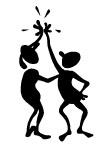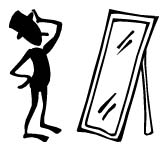|
seven critical rules for trade show success
home |
more trade show marketing articles
 There
are many factors that go into defining and achieving trade show success, but
there are seven critical elements, or rules, for being successful at trade show
exhibiting. Some will call these rules "trade show secrets" or "trade show
tricks", but the only secret is there is no secret, and there certainly aren't
any tricks or short cuts. These seven rules for tradeshow success are simple,
basic common sense. They aren't necessarily easy to implement, nor does it seem
that most trade show exhibitors follow all of them, but if you want to be a
trade show success and do well at trade show marketing, then study and learn
from these Seven Rules for Trade Show Success. These rules, strategies, and
techniques not only apply to trade shows
but also apply to convention, conference, and event marketing, and many
other forms of marketing too. Of course, your level of success will depend on
what your product or service is. It must meet a real need and provide value to
your customers. You need to have a U.S.P. (unique selling proposition), and you
need to know what it is. Often, the first step to marketing success is being
able to answer the questions, "Who is your customer? What do you do for them?
How are you better than your competition?" But, assuming you can answer those
questions, then let's begin... There
are many factors that go into defining and achieving trade show success, but
there are seven critical elements, or rules, for being successful at trade show
exhibiting. Some will call these rules "trade show secrets" or "trade show
tricks", but the only secret is there is no secret, and there certainly aren't
any tricks or short cuts. These seven rules for tradeshow success are simple,
basic common sense. They aren't necessarily easy to implement, nor does it seem
that most trade show exhibitors follow all of them, but if you want to be a
trade show success and do well at trade show marketing, then study and learn
from these Seven Rules for Trade Show Success. These rules, strategies, and
techniques not only apply to trade shows
but also apply to convention, conference, and event marketing, and many
other forms of marketing too. Of course, your level of success will depend on
what your product or service is. It must meet a real need and provide value to
your customers. You need to have a U.S.P. (unique selling proposition), and you
need to know what it is. Often, the first step to marketing success is being
able to answer the questions, "Who is your customer? What do you do for them?
How are you better than your competition?" But, assuming you can answer those
questions, then let's begin...
1. Pick the right trade show.
While this may seem like an obvious point, it's not always as simple as it
seems. You need to pick the right show with the most and best potential. For example, it
you are a boat builder, you may not want to just pick the biggest boat show in
the country. Do you sell salt water boats or fresh water boats? Do you sell
fishing boats, racing boats, or water skiing boats? How much does it cost to
deliver a finished boat, and are you competitive if you are trying to sell to
people on the other side of the country? Sometimes a general (boating) trade
show makes more sense, other times a more specific niche trade show makes sense.
It's important to know as much as you can about the trade show attendees. Most
exhibition companies will supply you with the demographics for the attendees.
How many of them are potential prospects and customers? Are they decision
makers? Do they have the necessary budget? In general, you want to shot for the
most "target rich" trade show, convention, or conference that you can find.
2. Set Your Goals.
You need to set clear goals and have a
strategy. Why are you exhibiting at the trade show and what
do you hope to achieve? How will you define
success? Do you need 200 new
orders? Do you need $250,000 in new orders? How are you going to accomplish
this? It's better to have goals that are "financial" instead of "hopeful". A
goal of generating 100 new leads doesn't really say much (since a lead may or
may not turn into a sale), and is what I refer to as a "hopeful" goal. A
concrete "financial" goal would be 100 new customers or 100 new orders.
3. Budget and Plan for Profit.
Before you commit to exhibit at a trade show, you need to determine a budget and
make sure you'll make a profit. Your trade show budget needs to cover the cost
of traveling to the show, the cost for the trade show booth space and
booth accessories (carpeting, plants,
electric and internet service, etc), the cost for your trade show display and
graphics, dreyage, other tradeshow
convention center costs, lodging, trade
show giveaways (if you use them), etc, etc, etc. Trade show exhibiting and
marketing isn't cheap. You then need to determine what you'll accomplish by
exhibiting at the show, and specifically how much money (profit) in return
you'll get. What is your ROI (return on investment)? Unless you can show with
confidence that you'll actually make a profit by trade show exhibiting, you
should probably reconsider whether or not you should do it.
4. Advertise and Promote in Advance.
Don't make the fatal mistake of thinking you can just show up and the trade show
and sit down in a comfy chair at your trade show booth, and then you'll be
swamped with trade show traffic and crowds. If you make this mistake, your booth
will more likely resemble a trade show wasteland instead of being the popular
trade show booth of your dreams. Get a list of the attendees from the trade show
organizer and send out a mailer to them announcing that you'll be at the show,
and what you'll be showing and where your booth is (your booth number). Offer to
reward people that stop by your booth with a trade show giveaway, or a discount
on any order they place at the show. Let them know in advance and
give them a
reason to stop by your trade show booth. Also remember to let all your existing
customers know that you'll be exhibiting at the trade show and tell them why
they should attend the show and stop by your booth.
5. Make Your Trade Show Display and Trade Show
Booth EFFECTIVE!
It doesn't really matter if your trade show display has the newest high-tech
features or if it is made out of 50% post-consumer recycled products. What does
matter is that it must be effective, and it must draw a crowd. If you want to be
a trade show success, you must have a trade show display with effective
graphics! Your tradeshow graphics must draw attention to your booth, and
communicate who you are, what you do, and how you help people. You also need a
trade show display and a trade show booth that make your company look
professional. You want to communicate value, trust, and reliability. At any
trade show, you'll have plenty of trade show competition... other trade show
booths and trade show exhibitors who are offering the same or similar services
and products. You must distinguish your company from the competition! You need
effective graphics. Make sure they are in your trade show budget!
6. Know Your Stuff and Know All the Answers.
You need to think about all the questions you might be asked at the trade show,
and you need to have answers. You need to make sure all of your trade show staff
know those answers as well. You and your staff must be completely knowledgeable
about your company and what it offers. Your trade show booth is not the place to
answer a prospect with, "I don't know. Let me get back to you on that." You need
to know.
7. Follow Up
After the show, you need to follow up with everyone you met and talked to at the
show. You need to follow up promptly. And you need to follow up with EVERYONE.
There's no point in getting leads at a trade show if you don't then
follow up on them.
 The
Secret BONUS 8th Trade Show Rule.. The
Secret BONUS 8th Trade Show Rule..
Although I said that there are no trade show secrets or trade show tricks for
tradeshow success, I will share this secret bonus 8th trade show success
strategy. Consider it a top secret insider tip, and guard it and use it
accordingly. This secret tip doesn't apply to all trade show exhibitors, and not
all trade show marketers can pull it off...
Consider the trade show as a war, which many consider trade show marketing and
marketing in general to be, for after all, you're battling against the
competition for the attention, time, and budgets or the trade show attendees. If
you want to win the trade show war, if you want to achieve trade show victory
and triumph, if you want to fight the good fight and defeat your trade show
enemies, then you need to act like you're at war and dress accordingly. Soldiers
wear uniforms, and so should your trade show booth staff. The Secret 8th Trade
Show Rule is to come up with a unique trade show uniform for your staff.
Differentiate your trade show booth from the other trade show booths by having
all of your trade show staff dress alike, and wear something that really stands
out. You could all wear fuzzy green top hats, or wear florescent pink t-shirts
that say "we're company XYZ and we do PQF the best." When a group of people are
dressed the same (and uniquely), it's hard to miss them, and any simple message
they're wearing. If the message is about how they can help a prospect, it's very
likely to get a response. But as I said, not all companies can employ this eight
rule for trade show success (imagine an investment banker in a florescent pink
t-shirt), which is why we'll keep it top secret for now.
more trade show marketing articles
Institute
for Trade Show
Marketing Excellence | ITSME
http://www.TradeShowMarketingAdvice.org
copyright 2004-2015 all rights reserved
|